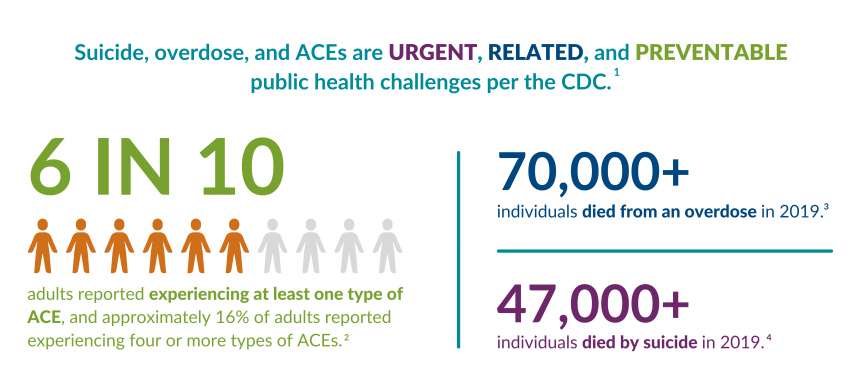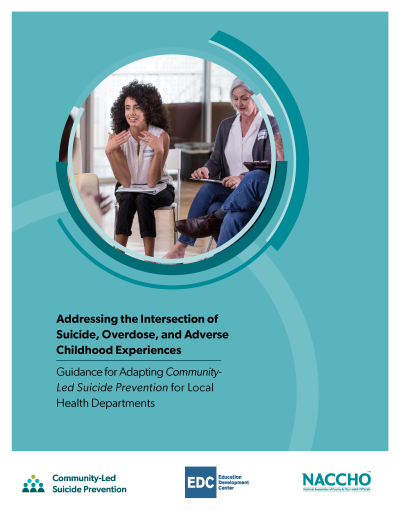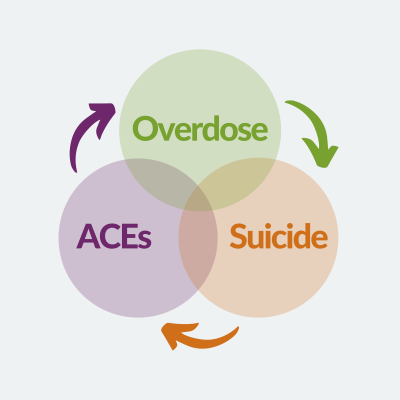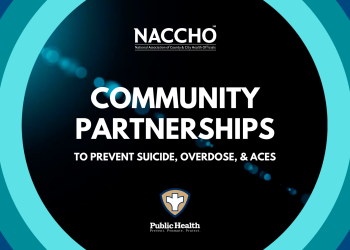Intersection of Suicide, Overdose, and Adverse Childhood Experiences
The intersection of suicide, overdose, and adverse childhood experiences (ACEs) is an exceedingly critical area in the field of public health. The relationship between these three issues is complex, as they share overlapping risk and protective factors and can lead to harmful social and behavioral health outcomes.

Such outcomes can affect the mental, physical, and emotional health of individuals, families, and communities across generations. The development and implementation of comprehensive strategies that aim to reduce risk factors and enhance protective factors may help prevent and mitigate future harms.
This webpage will serve as a resource hub on this issue, providing information, resources, and tools for local health departments seeking to build their capacity to address these converging epidemics within their own communities.

Just Released: A new resource from NACCHO and EDC, Addressing the Intersection of Suicide, Overdose, and Adverse Childhood Experiences, can help advance the vital work of health departments. The resource guides health departments and their partners in using the CDC-supported Community-Led Suicide Prevention Toolkit to take a comprehensive, collaborative approach to addressing shared protective and risk factors, strengthening support, and improving outcomes for people of all ages.
With support from the Centers for Disease Control and Prevention (CDC), NACCHO began work with the Association for State and Territorial Health Officials (ASTHO) to create a tool designed to assess capacity in suicide, overdose, and ACE prevention.

Acknowledging the urgency to address the threats of these issues potentially exacerbated by the COVID-19 pandemic, the Suicide, Overdose, and ACE Prevention Capacity Assessment Tool (SPACECAT) was developed.
SPACECAT will help health departments build and sustain their capacity to address these topics through the identification of cross-cutting needs and gaps in their prevention strategies. This assessment tool can provide insight for strategic planning, program improvement, technical assistance requests, and relevant funding opportunities. SPACECAT can strengthen local, state, and territorial health agency capacity to address their jurisdiction’s needs now and in the future.
The National Association of County and City Health Officials (NACCHO) is pleased to announce the launch of “Addressing the Intersection of Suicide, Overdose, and Adverse Childhood Experiences: What Is the Capacity of Local Health Departments?” This national fielding report summarizes local health departments’ capacities to address suicide, overdose, and adverse childhood experiences (ACEs) and provides recommendations to local health departments engaging in these efforts.
NACCHO also developed an infographic to accompany the the above national fielding report. This infographic provides key findings from the national fielding report.
The report and infographic were developed with funding from the CDC. If you have any questions about the report, please contact the NACCHO Injury and Violence Prevention Team at [email protected].
NACCHO is collecting resources to help LHDs develop their capacity in those areas identified by the results of the SPACECAT tool.
These tools and resources are mapped to the domains within the SPACECAT Tool and are divided into two categories: Infrastructure Capacity and Topical Capacity.
Additional information overviewing these topic areas can be found through the CDC’s Injury Center:
- Adverse Childhood Experiences, Overdose, and Suicide
- Urgent, Related, Preventable: Adverse Childhood Experiences, Overdose, and Suicide
- CDC APHA Infographic and Description
For any requests to submit materials that support for LHDs and their partners, please contact us at [email protected].
This collection of resources provides guidance for building public health infrastructure at the local level that addresses the areas of suicide, overdose, and ACEs. These resources can also be used to gauge an agency's capacity to build infrastructure.
This collection of tools and resources helps LHDs develop their knowledge and ability to implement evidence-based prevention strategies for suicide, overdose, and ACEs.
- National Strategy for Suicide Prevention Implementation Assessment Report (National)- A report from the Substance Abuse and Mental Health Services Administration that outlines the national strategy for suicide prevention.
- Suicide Prevention Resource Center (State)- A collection of resources from the Suicide Prevention Resource Center that contains resources and programs, training, and state activities for suicide prevention.
- State Suicide Prevention Infrastructure Recommendations (State)- A framework from Suicide Prevention Resource Center that provides guidance and recommendations on state suicide prevention infrastructure.
- Implementing Zero Suicide in Health Care (National)- A resource repository from The Action Alliance that contains an index of resources regarding suicide prevention and health care.
- Zero Suicide Toolkit (National)- A toolkit from ZeroSuicide that houses various suicide prevention resources, organized across seven elements.
- Resources (National)- A webpage from Zero Suicide that contains a multitude of resources to help users understand and implement Zero Suicide.
- Building Hope and Resiliency: A Collaborative Approach to Suicide Prevention in Riverside County (National)- A report from Riverside University Health System that outlines Riverside County's strategic plan for suicide prevention.
- Emergency Room Intervention for Suicidal Adolescent Females (National)- A program description from El Dorado County that overviews their Emergency Room Intervention program, an evidence-based practice that has shown success during the 3-year study.
- Youth Suicide Prevention Programs by State (National)- A resource repository from Kognito that list youth suicide prevention resources by state.
- Rural Project Examples: Suicide and Suicide Prevention (Local)- A resource repository from Rural Health Information that contains examples of suicide and suicide prevention programs in rural communities.
- Rural Suicide Prevention Toolkit (Local)- A toolkit from Rural Health Information divided into modules that contains resources focused on the development, implementation, evaluation and sustainment of rural suicide prevention programs. The toolkit also contains evidence-based and promising suicide prevention programs models for rural communities.
- Suicide Prevention: Resource for Action (National) - A resource from the centers for Disease Control and Prevention that details strategies with the best available evidence to reduce suicide.
- Suicide Prevention (National)- A resource repository from the Centers of Disease Control and Prevention that contains a host of suicide and suicide prevention resources including CDC's strategic plan, suicide prevention programs, CDC publications and other resources.
- State of State, Territorial, and Tribal Suicide Prevention (National)- A report developed by the Centers for Disease Control and Prevention detailing the suicide prevention strategies of states, territories, and tribes.
- The Surgeon General's Call to Action to Implement the National Strategy for Suicide Prevention: A Report of the U.S. Surgeon General and of the National Action Alliance for Suicide Prevention (National)- A report developed by the Centers for Disease Control and Prevention detailing the suicide prevention strategies of states, territories, and tribes.
- Preventing Suicide: A Technical Package of Policy, Programs, and Practices (Local)- A report from the Centers for Disease Control and Prevention that contains descriptions of policies, programs, and practices that prevent suicide.
- State Suicide Prevention Planning: A CDC Research Brief (Local)- A report from the Centers for Disease Control and Prevention that presents the findings of a state suicide prevention planning study.
- Injury Prevention Inventory: A Compendium of Injury Prevention Strategies, Sample Measures, & Resources for Suicide (Local)- A resource repository from Safe States that outlines several strategies and accompanying resources, sample measures, and other additional resources.
- Essential Measures: A Local Public Health Toolkit for Addressing the Opioid Epidemic (Local)- A toolkit from the Massachusetts Health Officers Association that has explanations, case examples, and resources for responding to the opioid epidemic through local public health, organized by the ten essential services.
- Post-Overdose Response Team Toolkit (National)- A toolkit from the North Carolina Department of Health and Human Services that helps communities assess the need for a post-overdose response team, design and implement the program, and evaluate the program to make improvements.
- Implementing Medication-Assisted Treatment for Opioid Use Disorder: A Planning and Implementation Toolkit (National)- A toolkit from the National Council for Behavioral Health that contains information to advance the implementation of evidence-based medications for opioid use disorder within jail and prison settings..
- Medication-Assisted Treatment for Opioid Use Disorder Playbook (Local)- A practical guide from The AHRQ Academy that provides information for primary care providers implementing medication-assisted treatment, particularly in rural settings.
- Resources for Health Professionals, Patients and Community (Local)- A collection of resources from the Providers Clinical Support System that treat opioid use disorder and chronic pain for health professionals, patients, family members, and the community.
- Law Enforcement Naloxone Toolkit (Local)- A tool from the Bureau of Justice Assistance that identifies resources such as trainings, educational materials, policies/procedures, and reports that may help strengthen law enforcement’s capacity to prevent and respond to the overdose epidemic.
- Syringe Services Programs: A Technical Package of Effective Strategies and Approaches for Planning, Design and Implementation (National)- A technical package from the Centers for Disease Control and Prevention that provides a broad framework for new and existing syringe service programs to ensure needs-based service delivery, reduce harms related to injection drug use, and link participants to services that support their health and wellness.
- Guide to Establishing Syringe Services Programs in Rural, At-Risk Areas (National)- A comprehensive guide from the Comer Family Foundation with harm reduction resources and specific examples from communities in Kentucky, West Virginia, Indiana, and North Carolina.
- Strategic Planning Guide: Guidance and Resources to Assist State and Territorial Health Agencies in Developing a Strategic Plan (National)- A framework from the Association of State and Territorial Health Officials that provides information on strategic planning for state and territorial health agencies.
- Local Public Health Assessment and Planning Cycle: Strategic Plan (National)- A guide from the Minnesota Department of Health on strategic planning for community health boards.
- Strategic Planning (National)- A guideline from the Suicide Prevention Resource outlying their strategic planning approach to suicide prevention. A free online course is also available as an additional resource.
- Strategic Planning Tools, Resources, and Considerations for Overdose Data to Action-Funded Jurisdictions (National)- A resource from the Association of State and Territorial Health Officials containing technical assistance, tools, and other resources for strategic planning on the state and local level.
- Planning: Developing the Coalition's Vision, Mission, Objectives, Strategies and Action Plans (Local)- A practical guide from The AHRQ Academy that provides information for primary care providers implementing medication-assisted treatment, particularly in rural settings.
- A Rapid-Cycle Assessment Strategy for Understanding the Opioid Epidemic in Local Communities (Local)- A report from the Allegheny County Health Department that describes the rapid-cycle assessment approach used with their Community Opioid Project.
- Overdose Prevention (Local)- A resource repository from the Centers for Disease Control and Prevention that contains information on opioid prescribing, treatment for opioid use disorder, overdose reversal, and evidence-based strategies for prevention.
- Evidence-Based Strategies for Preventing Opioid Overdose: What's Working in the United States (Local)- A report from the Centers for Disease Control and Prevention that presents evidence-based strategies for preventing opioid overdose for public health, law enforcement, and community organizations.
- Conducting Affordable Care Act, Community Health Needs Assessments (CHNA) Targeted at the Opioid Overdose Epidemic(National)- A practicum project developed with NACCHO that provides guidance on how the CHNA process can address substance misuse.
- Opioid Epidemic Toolkit 2021 (National)- A toolkit from NACCHO that contains a multitude of resources, organized by topic and level, that support local health departments in their overdose prevention efforts.
- Build State, Local, and Tribal Capacity to Respond to Opioid Overdoses (National)- A resource repository from the Centers for Disease Control and Prevention that provides information on programs working to build capacity in state, local communities, and tribes to prevent opioid overdoses.
- Opioid Overdose Prevention Toolkit(National)- A toolkit from the Substance Abuse and Mental Health Services Administration that includes education on opioid use disorder, essential steps for first responders, information for prescribers, safety advice for patients and their families, and recovery strategies after experiencing an overdose.
- St. Mary's County Overdose Prevention Plan (National)- An overdose prevention plan from St. Mary's County that includes data analysis, a series of planned interventions, and a description of measurement plans for performance metrics.
- Useful Resources on Opioid Overdose Prevention in Homeless Population (National)- A collection of resources from the Substance Abuse and Mental Health Services Administration for overdose prevention specifically in relation to people experiencing homelessness.
- Overdose Prevention and Response (National)- A local initiative from King County that contains data dashboards, evaluations and reports, policy and opioid response plans, and other services and resources involving overdose prevention and response.
- Harm Reduction Resource Center (National)- A collection of resources from the National Harm Reduction Coalition categorized by issue and type, including brochures, fact sheets, webinars, training guides, and podcasts.
- Templates for Local Health Department Opioid Prevention & Response: A How To Guide (National)- A reference document from NACCHO that supports local health departments as they plan for, implement, and evaluate their efforts using NACCHO’s Action Plan, Budget Plan, and Evaluation Plan Templates.
- Local Opioid Prevention and Response: A Primer for Local Health Departments (National)- A primer from NACCHO that informs local health departments about the domestic opioid epidemic and share success stories. The Primer covers five types of activities including: monitoring and surveillance, prevention, harm reduction, linkages to care, and stakeholder engagement and community partnerships.
- The Opioid Use Disorder Prevention Playbook (State)- A “playbook” from the National Interoperability Collaborative highlighting strategies that communities can replicate or adapt in real time to prevent opioid use disorder.
- Rural Opioid Educational Resources (Local)- A comprehensive repository of resources from the National Organization of State Offices of Rural Health for opioid response in rural communities, including customizable resources, training materials, and reports.
- A Sustainability Planning Guide for Healthy Communities (Local)- A framework from the Centers for Disease Control and Prevention that outlines sustainability policy strategies and science-and-practice-based evidence in order to aid agencies in the development, implementation, and evaluation of their own sustainability plans.
- Program Sustainability Assessment Tool (State)- A tool from the Centers for Public Health Systems Science that helps agencies rate the sustainability capacity of their programs.
- Preventing Adverse Childhood Experiences: Leveraging the Best Available Evidence (National)- A report from the Centers for Disease Control and Prevention that contains information on evidence-based ACE prevention practices.
- Trauma-Informed Toolkit for Health Care Providers (National)- A toolkit from the Health & Medicine Policy Research Group and the Illinois ACEs Response Collaborative that includes assessment tools, samples presentations, staff wellness resources, videos on trauma-informed, and ACEs 101 resources.
- Exploring the Rural Context for Adverse Childhood Experiences (ACEs) (National)- A report from the National Advisory Committee on Rural Health and Human Services that includes a policy brief and recommendations for ACEs in rural areas.
- Resilience Catalysts in Public Health (State)- A program description from Center for Community Resilience, NACCHO, and the American Public Health Association that provides an overview of the Resilience Catalyst network and the use of the Community Resilience framework.
- Child Abuse and Neglect (State)- A resource repository from VetoViolence on child abuse and neglect prevention, including general information, CDC-developed resources, and data on the subject.
- ACEs Aware (State)- A resource repository from ACEs Aware that contains information, trainings, and resources on the fundamentals of ACEs, including the science of ACEs and toxic stress, trauma-informed care, ACEs screening, and treatment.
- Preventing Child Abuse and Neglect: A Technical Package for Policy, Norm, and Programmatic Activities (National)- A technical package from the Centers for Disease Control and Prevention that provides evidence-based strategies to prevent child abuse and neglect.
- Adverse Childhood Experiences (ACEs) (National)- A resource repository from the Centers for Disease Control and Prevention that includes information about prevention strategies, ACEs for youth at risk, ACE data, and funded research.
- A Review of Community Efforts to Mitigate and Prevent Adverse Childhood Experiences and Trauma (Local)- A report from Washington State University that discuss how to create a public health model for ACEs prevention and mitigations, the evidence base for community prevention efforts, and community programs defining ACEs-related collaborative efforts.
- Integrating ACE-Informed Practice into the Blueprint for Health (National)- A literature review from the Department of Vermont Health Access detailing evidence-based practices and interventions that reduce and treat ACEs.
- Preventing and Mitigating the Effects of Adverse Childhood Experiences (National)- A report from the National Conference of State Legislatures that describes evidence-based state ACE prevention strategies.
- Additional Resources for Creating Safe, Stable, and Nurturing Relationships and Environments (National)- A resource repository from the Kansas Department of Health and Environment that contains links to several resources including Baby Buffer, the Building Community Resilience Collaborative, and The Resilience Project.
- Child Abuse Prevention and Child Welfare: Collaborating for Creative Solutions (Local)- A framework from FRIENDS National Resource Center for Community-Based Child Abuse Prevention that provides guidance on developing collaborations.
- Collaboration Toolkit (State)- A toolkit from FRIENDS National Resource Center for Community-Based Child Abuse Prevention that provides tools and resources, categorized across ten elements.
- Neglect Toolkit (National)- A toolkit from FRIENDS National Resource Center for Community-Based Child Abuse Prevention that serves to assist state agencies and other partners in their comprehension of neglect. The toolkit also contains strategies, specific examples, and other resources about child neglect.
- Kitsap Strong Impact Report (National)- A report from Kitsap Community Foundation that highlights their work to increase health and safety outcomes for children and families.
- Evidence-Based Programs/Data (Local) - A resource repository from PACES Connection that includes evidence-based ACE prevention programs and ACE measures.
- Adverse Childhood Experiences: Madison County Department of Public Health (State)- A report from Madison County Department of Health that includes current local ACE prevention initiatives and prevention recommendations organized by tier.
- Programs Addressing ACEs and Trauma in Illinois (State)- An environmental scan conducted by the Health & Medicine Policy Research Group and the Illinois ACEs Response Collaborative identifying programs addressing ACEs and trauma.
- Essentials for Childhood Resources (State)-A resource repository from the California Department of Health that includes: an e-guide, data reports, fact sheets, and frameworks, among other resources.
- Adverse Childhood Experiences and Resilience: Understanding, Addressing, and Preventing Community Trauma (National)-A resource repository from the Prevention Institute that contains publications, local initiatives, frameworks, and media covering ACEs and community trauma.
- Suicide and ACEs Prevention Multimedia Resources (National)- A resource repository from the Prevention Institute that contains multimedia resources, including briefs, podcasts, and webinars, on suicide and ACEs prevention.
- The Intersection of Opioid Abuse, Overdose, and Suicide: The Role of Chronic Pain (Local)- A resource repository from the Prevention Institute that contains multimedia resources, including briefs, podcasts, and webinars, on suicide and ACEs prevention.
- The Intersection of Opioids and Suicide: Prevention Approach (Local)- A webinar from the Substance Abuse and Mental Health Services Administration Office of Behavioral Health Equity that provides information and data on the intersection of opioids and suicide.
- Adverse Childhood Experiences and Suicide Prevention Rapid Response Training and Technical Assistance Tools (Local)- A resource repository from the Prevention Institute containing numerous training modules, videos, webinars, presentations, and other resources on topics such as suicide prevention, equity prioritization, trauma, and combating these issues during COVID-19.
- The Intersection of Opioid Abuse, Overdose, and Suicide: Understanding the Connections (Local)- A comprehensive "playbook" from Practical Playbook that provides information on building multisector partnerships including sustainability and finance, policy, training and workforce, data, and engaging diverse sectors.
- Veto Violence: Connecting the Dots (National)- A webpage from VetoViolence that provides tools including an online training, connections selector, and notes from the field that explore the overlap between multiple forms of violence.
- Suicide & Adverse Childhood Experiences (ACEs): Preventing Suicide through Collaborative Upstream Intervention (National)- A webinar from the Suicide Prevention Resource Center that focuses on the importance of incorporating ACEs in comprehensive suicide prevention efforts.
Community Health Program
Stacy Stanford
Senior Director, Overdose, Injury, and Violence Prevention
JavaScript is required to reveal this message. / Email
Community Health Program
Caroline Snyder
Director, Injury and Violence Prevention
JavaScript is required to reveal this message. / Email
References
1. United States, Centers for Disease Control and Prevention, National Center for Injury Prevention and Control. (n.d.). Urgent, Related, Preventable: Adverse Childhood Experiences, Overdose, and Suicide. Retrieved 2021, from https://www.asam.org/docs/defa...
2. Merrick MT, Ford DC, Ports KA, et al. Vital Signs: Estimated Proportion of Adult Health Problems Attributable to Adverse Childhood Experiences and Implications for Prevention — 25 States, 2015–2017. MMWR Morb Mortal Wkly Rep. 2019;68(44):999-1005. doi:10.15585/mmwr.mm6844e1
3. Hedegaard, M.D., H., & Spencer, M.P.H., M. R. (2021, March). NCHS Data Brief: Urban-Rural Differences in Drug Overdose Death Rates, 1999-2019 (Rep. No. 403). Retrieved April, 2021, from U.S. Department of Health and Human Services website: https://www.cdc.gov/nchs/data/...
4. WISQARS (Web-based Injury Statistics Query and Reporting System)|Injury Center|CDC. Accessed March 26, 2021. https://www.cdc.gov/injury/wis...





